
Dacrydium cupressinum, commonly known as rimu, is a large evergreen coniferous tree endemic to the forests of New Zealand. It is a member of the southern conifer group, the podocarps. The former name "red pine" has fallen out of common use.

Lake Waikareiti, also spelt Lake Waikare Iti, is located in Te Urewera National Park in the North Island of New Zealand. A number of hiking trails are found within the catchment basin of the lake.

Pseudopanax is a small genus of 12–20 species of evergreen plants, the majority of which are endemic to New Zealand. Flowers of the genus occur in terminal umbels.

Te Urewera is an area of mostly forested, sparsely-populated rugged hill-country in the North Island of New Zealand, much of it in the northern Hawke's Bay Region, and some in the eastern Bay of Plenty Region. Much of it lies in the Huiarau, Ikawhenua, and Maungapohatu ranges, and there are also lowland areas in the north. The Waikaremoana and Waikareiti lakes lie in the south-eastern part.

Cranfillia fluviatilis, synonym Blechnum fluviatile, is a fern known in the Māori language as kiwikiwi. A herbaceous plant, C. fluviatilis is a "hard fern" of the genus Cranfillia in the family Blechnaceae. It was identified by Patrick Brownsey in 1979. Other common names are star fern, creek fern, kawakawa and kiwakiwa.
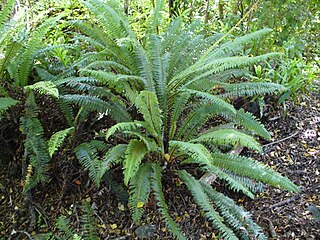
Lomaria discolor, synonym Blechnum discolor, commonly called crown fern, is a species of fern in the family Blechnaceae. This species is endemic to New Zealand. As noted by C. Michael Hogan, this species is found in a number of forest communities in diverse locations within New Zealand, and is sometimes a dominant understory component.

Leptecophylla juniperina is a species of flowering plant in the family Ericaceae. The species is native to New Zealand and the Australian states of Tasmania and Victoria. The plant's fruit is edible, raw or cooked. Plants grow best in areas with moderate winters and cool moist summers.

Asplenium flaccidum is a species of fern in the family Aspleniaceae. The plant common name is drooping spleenwort or weeping spleenwort, and the species name flaccidum derives from the Latin root meaning drooping. An example occurrence of A. flaccidum is within a Nothofagus-Podocarp forest at Hamilton Ecological District on New Zealand's North Island in association with other fern species understory plants, crown fern, Blechnum discolor being an example.
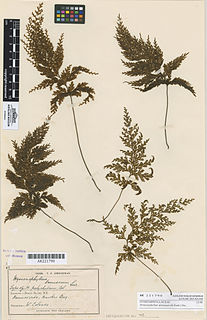
Hymenophyllum demissum is a species of fern in the family Hymenophyllaceae. H. demissum is found in New Zealand, with a specific example occurrence being in North Island's Hamilton Ecological District in a Nothofagus-podocarp forest in association with other fern species understory plants, crown fern, Blechnum discolor being an example.

Alseuosmia is a genus of five species of flowering plants in the family Alseuosmiaceae, growing in New Zealand's North Island. Species members are characteristically small evergreen shrubs. An example occurrence of species representative Alseuosmia macrophylla is in the habitat of the Hamilton Ecological District, where Blechnum discolor and B. filiforme are understory elements with a Nothofagus truncata and Dacrydium cupressinum overstory.
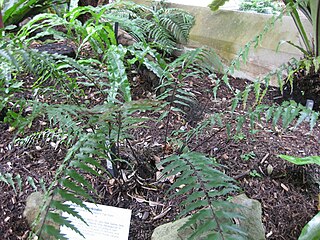
Asplenium polyodon, commonly known as sickle spleenwort, is a species of fern in the family Aspleniaceae. The distribution of A. polyodon includes parts of the countries of Australia and New Zealand. A specific locale of occurrence is in forested areas of Westland, New Zealand, where associate understory species include crown fern.
Coprosma spathulata is a shrub that is native to New Zealand. An example occurrence of this species is within the Hamilton Ecological District in the North Island within a forest dominated by Nothofagus and rimu, where understory associates include Blechnum discolor and Doodia media.
Astelia trinervia is a species of rhizomatous tufted perennial native to New Zealand. An example occurrence of this species is in the North Island's Hamilton Ecological District, where it occurs in the understory associated with Blechnum discolor and overstory forest elements of rimu and nothofagus trees.

Phyllocladus alpinus, the mountain toatoa or mountain celery pine, is a species of conifer in the family Podocarpaceae. It is found only in New Zealand. The form of this plant ranges from a shrub to a small tree of up to seven metres in height. This species is found in both the North and South Islands. An example occurrence of P. alpinus is within the understory of beech/podocarp forests in the north part of South Island, New Zealand.

The Spenser Mountains is a topographic landform in the northern South Island of New Zealand. Located at the southern end of the Nelson Lakes National Park and north of the Lewis Pass they form a natural border between the Canterbury and Tasman regions. Several peaks are named after characters in Edmund Spenser’s allegorical poem, The Faerie Queene. Many of the early explorers were evidently literate men. For example, Frederick Weld named Lake Tennyson; William Travers named the Spensers and Faerie Queene; Julius Haast named Mt Una.

Raukaua simplex is a species of evergreen plant in the Araliaceae family. This species is native to New Zealand. The species occurs in certain lowland, montane and subalpine forests from the Waihou River southward to Stewart Island and the Auckland Islands. An example occurrence in Westland forests includes associates such as Cyathea smithii and Dicksonia squarrosa.
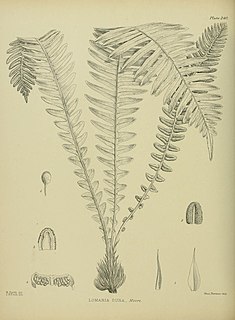
Austroblechnum durum, synonym Blechnum durum, is a species of fern in the family Blechnaceae. The fern is endemic to New Zealand.
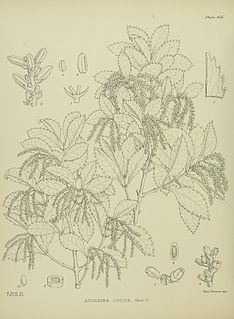
Ascarina lucida, commonly known as hutu is a species of small tree in the family Chloranthaceae. It is endemic to New Zealand, being common on the West Coast and Nelson regions of the South Island and more rarely found in the North Island. A typical plant association is within the Westland podocarp/broadleaf forests with common understory associates of Blechnum discolor, Pseudowintera colorata, Pseudopanax colensoi and Coprosma lucida. Most genus members are dioecious, producing unisexual male or female flowers on separate plants. Ascarina lucida, the only member of its genus to occur in New Zealand, is monoecious. It will grow to a height of 6m and can have a 30 cm trunk. The leaves which are in opposite pairs are simple, yellowish green in color, have a raised mid rib and are very similar to Laurelia novae-zelandiae. Their margins have prominent teeth which are dark colored at the tips. Ascarina lucida is now nearly extinct in the Taranaki region but was last reported in Oct 1969 at Mt Taranaki, near Pukeiti by Colin Ogle.
Pseudopanax colensoi is a species of evergreen plant. This species is native to New Zealand. An example occurrence in central Westland podocarp/broadleaf forests includes flora associates such as Cyathea smithii and Dicksonia squarrosa, Rumohra adiantiformis, Ascarina lucida, Pseudowintera colorata and Blechnum discolor. The maximum height of this plant is 5 meters and it is the preferred food of possums.
Pseudopanax edgerleyi is a species of plant which is native to New Zealand. An example occurrence in Westland District Podocarp/broadleaf forests includes flora associates such as Cyathea smithii, Dicksonia squarrosa and Blechnum discolor.
















